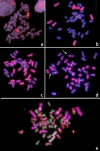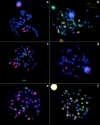Multiple rearrangements in cryptic species of electric knifefish, Gymnotus carapo (Gymnotidae, Gymnotiformes) revealed by chromosome painting
- PMID: 20420709
- PMCID: PMC2873553
- DOI: 10.1186/1471-2156-11-28
Multiple rearrangements in cryptic species of electric knifefish, Gymnotus carapo (Gymnotidae, Gymnotiformes) revealed by chromosome painting
Abstract
Background: Gymnotus (Gymnotidae, Gymnotiformes) is the Neotropical electric fish genus with the largest geographic distribution and the largest number of species, 33 of which have been validated. The diploid number varies from 2n = 39-40 to 2n = 54. Recently we studied the karyotype of morphologically indistinguishable samples from five populations of G. carapo sensu stricto from the Eastern Amazon of Brazil. We found two cytotypes, 2n = 42 (30 M/SM + 12 ST/A) and 2n = 40 (34 M/SM + 6 ST/A) and we concluded that the differences between the two cryptic species are due to pericentric inversions and one tandem fusion.
Results: In this study we use for the first time, whole chromosome probes prepared by FACS of the Gymnotus carapo sensu strictu species, cytotype with 2n = 42. Using two color hybridizations we were able to distinguish pairs 1, 2, 3, 7, 9, 14, 16, 18, 19, 20 and 21. It was not possible to separate by FACS and distinguish each of the following chromosome pairs even with dual color FISH: {4,8}; {10,11}; {5,6,17}; {12,13,15}. The FISH probes were then used in chromosome painting experiments on metaphases of the 2n = 40 cytotype. While some chromosomes show conserved synteny, others are rearranged in different chromosomes. Eight syntenic associations were found.
Conclusions: These results show that the karyotype differences between these cryptic species are greater than assumed by classical cytogenetics. These data reinforce the previous supposition that these two cytotypes are different species, despite the absence of morphological differences. Additionally, the homology of repetitive DNA between the two provides evidence of recent speciation.
Figures







References
-
- Neusser M, Stanyon R, Bigoni F, Wienberg J, Müller S. Molecular cytotaxonomy of New World Monkeys (Platyhrrini). Comparative analysis of five species by multicolor chromosome painting gives evidence for a classification of Callimico goeldii within the family of Callitrichidae. Cytogenetics and Cell Genetics. 2001;94:206–215. doi: 10.1159/000048818. - DOI - PubMed
-
- Barros RMS, Nagamachi CY, Pieczarka JC, Rodrigues LRR, Neusser M, De Oliveira EHC, Wienberg J, Muniz JAPC, Rissino JD, Muller S. Chromosomal studies in Callicebus donacophilus pallescens, with classic and molecular cytogenetic approaches: Multicolour FISH using human and Saguinus oedipus painting probes. Chromosome Research. 2003;11:327–334. doi: 10.1023/A:1024039907101. - DOI - PubMed
Publication types
MeSH terms
LinkOut - more resources
Full Text Sources

